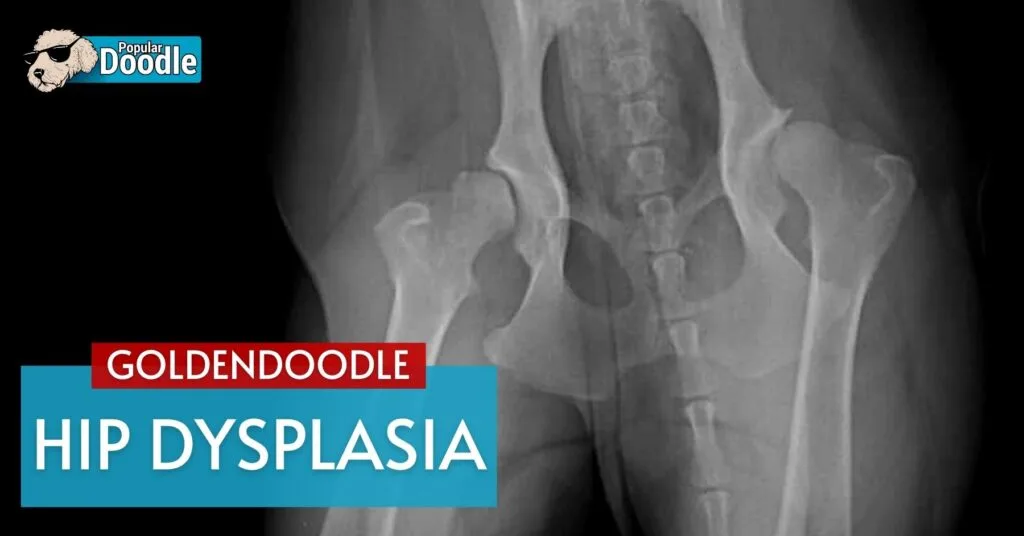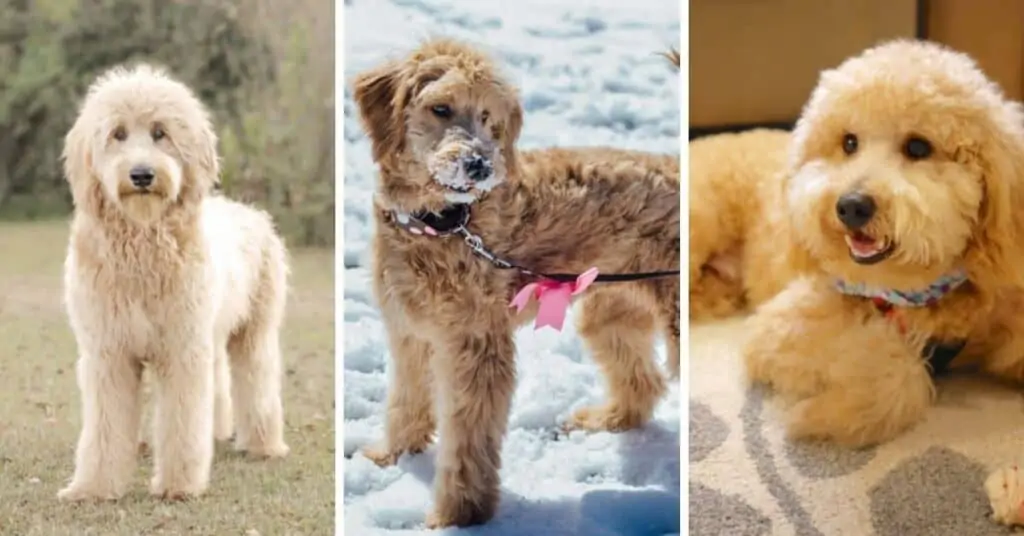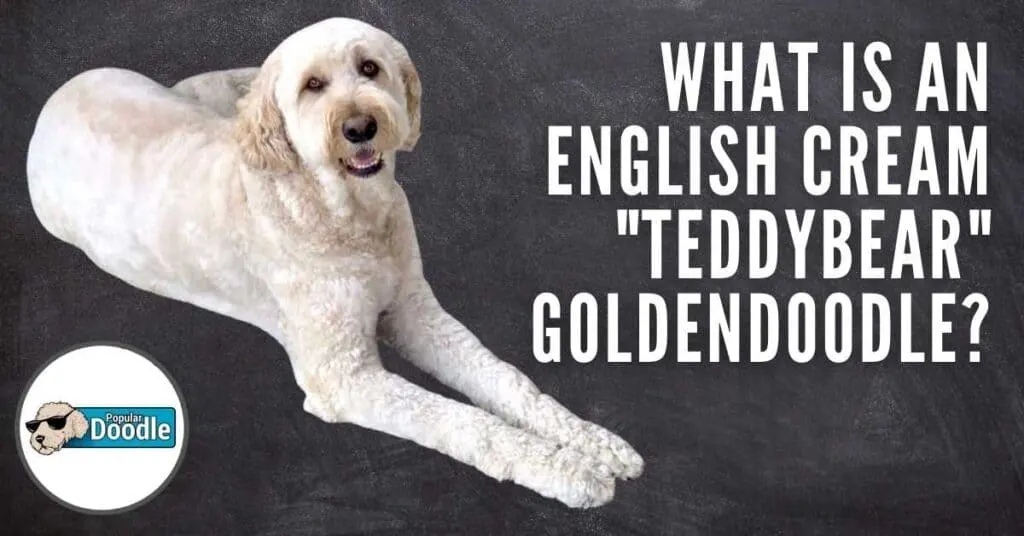By Dr. Merliza Cabriles, D.V.M.

Canine hip dysplasia is a painful, skeletal condition that can significantly reduce a Goldendoodle’s quality of life.
Naturally, many current and prospective owners of this breed have questions about this condition. Is it common? Is there anything we can do to prevent it? What treatment options are there?
I’m here to provide a veterinarian’s perspective on all these questions and more!
Are Goldendoodles Prone to Hip Dysplasia?
Goldendoodles are prone to hip dysplasia due to this hereditary condition being common in both the Poodle and Golden Retriever parent breeds. Due to their large stature, standard Goldendoodles have a significantly higher risk of hip dysplasia than smaller sizes of this breed.
Related: Goldendoodle Size Full Grown: How Big Do Goldendoodles Get? (Teacup, Toy, Mini, Medium, Standard)
A Goldendoodle with hip dysplasia may not show any symptoms for years yet still develop crippling arthritis as they age. This makes your dog’s regular health and wellness checks very important for early detection and intervention.
What is Hip Dysplasia?
Canine hip dysplasia is primarily a hereditary problem affecting the bones of the hip joint. It is often seen in large or giant breed dogs. However, small and medium-sized breeds can also be affected.
The hip joint is considered a ‘ball-and-socket joint.’ Ideally, the ball and socket in the pelvic bone should grow at equal rates. The ball should sit well in the socket, allowing a smooth gliding motion.
In Goldendoodle hip dysplasia, the ball of the thighbone may rest on the edge of the hip socket, or sometimes the socket is too shallow to hold the ball in place. This hip joint malformation results in the laxity of the joint.
As the puppy grows and develops, the defect causes structural changes in the joint. Since the parts of the joint (the ball and socket) don’t fit together normally, the bones will rub against each other. This bone-on-bone contact can lead to inflammation and instability of the hip joint.
In an attempt to stabilize the hip joint, the body responds to the inflammation by producing osteophytes (bone spurs) around the bones of the joint. As the rubbing of the bones continues over time, the joint will lose cartilage and scar tissue will develop.
The joint undergoes progressive degeneration and eventually osteoarthritis (long-term degenerative joint disease).
Signs & Symptoms of Hip Dysplasia in Goldendoodles
The severity of symptoms, particularly lameness, depends to a large extent on the changes in the joint that is associated with arthritis. These factors include how loose (laxity) the joint is, the severity of the disease, how long a Goldendoodle has hip dysplasia, and the level of inflammation.
Affected Goldendoodles may exhibit symptoms at any stage of the disease, but many dogs are asymptomatic until degeneration of joint structures is severe.
The symptoms of Goldendoodle hip dysplasia include the following:
- Lameness in the hind limbs.
- Decreased activity.
- Difficulty running, jumping, standing up, climbing stairs, or a reluctance to do these activities.
- Decreased range of motion.
- Stiffness or limping.
- Loss of muscle mass on the thighs.
- Bunny hopping or swaying while walking.
- Favoring the hind limbs by shifting weight to their forelimbs. This can lead to the enlargement of the shoulder muscles in their effort to compensate for the hind limb.
- Pain in the hip.
Can Goldendoodle Puppies Have Hip Dysplasia?
If one or both parents of a Goldendoodle puppy carries the gene for hip dysplasia, there is a high chance that the puppy can develop the defect.
Some Goldendoodles start to display signs of hip dysplasia as early as four months old. Others develop it along with osteoarthritis as they grow older.
Hip dysplasia begins in puppyhood, however, the majority of canines do not display symptoms until they are older. It can take years of gradual bone degeneration until symptoms present themselves.
A Goldendoodle puppy with arthritis may appear to have a limp or may be reluctant to climb stairs.
Is Goldendoodle Hip Dysplasia Curable? (Treatment Options)
There is no cure for Goldendoodle hip dysplasia. It’s a chronic problem that causes progressive deterioration of the affected joints.
The good news is that there are various treatment options to slow down the progress, provide pain relief, and alleviate arthritis symptoms. Many of these treatments can also help prevent further joint damage in puppies.
These can help ensure that your Goldendoodle can still have a better quality of life.
Exercise
Appropriate regular physical activity will strengthen muscles and prevent further degeneration of the joint tissues.
You can consult your veterinarian on how much exercise your Goldendoodle needs, but here are some rough guidelines. Too much exercise can damage your Goldendoodle’s muscles and joints.
Medications and Supplements
Some medications and supplements can help reduce pain and inflammation as well as strengthen your Goldendoodle’s joints. However, you should consult your veterinarian before starting your dog on anything.
Have a question for a vet? Click here to live chat instantly with a verified veterinarian!
Surgery
Surgery may be needed for extreme cases of hip dysplasia. Depending on the x-ray findings, the veterinary surgeon may recommend a total hip replacement or other options that will work for your pet.
You can also ask your veterinarian about ‘juvenile pubic symphysiodesis.’ It’s a minor surgical procedure intended for very young puppies of breeds with an elevated risk of developing hip dysplasia.
Orthopedic Braces
One of the most non-invasive, conservative ways to manage hip dysplasia in Goldendoodles are hip braces. These are available in various sizes and work by minimizing pressure on the dog’s joints. It can also prevent pain and discomfort during exercise.
A hip brace can also be used during the healing period after surgery.
Physical Therapy
Massage, hydrotherapy, and other methods of physical therapy, when performed by experienced and licensed professionals, can help alleviate pain. These procedures can also help increase your Goldendoodle’s mobility.
Acupuncture
It is an ancient practice of traditional Chinese medicine, which may help ease pain and improve joint range of motion.
Dog-Friendly Environment
Install ramps or steps to help your dog get into bed, into the car, or maneuver around your home. If your budget allows it, invest in an orthopedic bed.
A heated dog bed is very comfortable for your Goldendoodle, especially during cold weather. However, monitor the heating pads regularly because they can get very hot and burn your pet.
How to Prevent Goldendoodle Hip Dysplasia
Early intervention can help slow the progression of arthritis and reduce Goldendoodle hip dysplasia symptoms.
When getting a Goldendoodle puppy, choose one from a reputable breeder who screens their breeding dogs for hip dysplasia.
Experts believe that parents with healthy hips have increased chances of giving birth to offspring with healthy hips. While this does not guarantee that your puppy won’t develop hip dysplasia, it certainly improves the odds.
You should also ask the breeder for the BVA, OFA, OVD, or PennHIP results of the puppy’s parents.
While you can’t do anything about the genetic makeup of your Goldendoodle pup or that of its parents, there are ways to help delay or minimize the effects of this joint problem. These include the following:
- Slowing down your puppy’s growth rate.
- Maintaining your puppy’s weight within healthy limits.
- Regular age-appropriate exercise.
Diet
Large-breed puppies have special nutritional requirements. They should be given specially formulated puppy food that prevents excessive and rapid growth, which can pave the way for skeletal disorders and joint conditions such as hip and elbow dysplasia.
Slow growth enables the joints of these breeds to develop without the pup’s body weight exerting too much strain on them.
Puppies prone to developing hip dysplasia should not be given a high-fat, high-protein diet because it can lead to growth spurts that could strain a Goldendoodle pup’s developing joints.
Related: Should Goldendoodles Eat Grain Free? (Veterinarian Advice)
Exercise
Too much exercise or a sedentary life can also increase a Goldendoodle’s risk of developing hip dysplasia. If your dog is overweight or obese, the extra weight can put a lot of stress on the joints and worsen a pre-existing hip dysplasia or even cause the development of one.
Age-appropriate exercise is crucial for your puppy’s development. Excessive leash walking, running long distances, or repetitive stair or hill climbing can injure developing joints and muscles brought on by repetitive stress.
Weight
The excess weight of an overweight or obese Goldendoodle puppy can put undue strain on the weight-supporting joints of the body, such as the hips. It’s important to monitor your pet’s weight regularly, ensuring it is within a healthy range.
You can also ask your veterinarian how to assess your pup’s body condition score (BCS) by feeling their ribs under the hair coat.
Joint Supplements
Certain supplements, like glucosamine, MSM, and chondroitin, have been shown in studies to promote joint health. This can be incorporated into pet food formulas specially formulated for large-breed dogs.
If your Goldendoodle has been diagnosed with arthritis, your veterinarian will most likely recommend a daily dose of these supplements.
Pet Insurance
While pet insurance obviously won’t prevent hip dysplasia, it allows you to spare no expense when deciding on a treatment plan with your veterinarian.
Having a policy with a reputable company like Healthy Paws means you may only have to pay 10% of your Goldendoodle’s veterinary expenses!
Always read your policy before agreeing to ensure hip dysplasia is covered and know the applicable waiting period.

Dr. Merliza Cabriles, D.V.M.
Contributing Professional
Dr. Merliza Cabriles is a licensed veterinarian and university professor with many years of experience in food animal and pet companion medicine. Her passion for writing as well as pet parent education and support is echoed in the articles and ebooks she has written.









